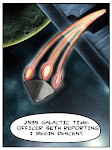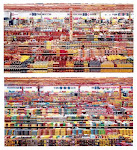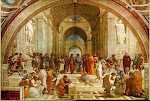Adaptations and new retellings of old stories establish an implicit dialogue with their predecessors. The outcome of this dialogue is what should interest any critic. Sometimes, however, the nature of dialogue is marred by the limitations of the new interlocutor –that is, in a dialogue, not all interlocutors are equally valid. Robert Zemeckis’ Beowulf (2007) could be deemed as a more than valid dialogical counterpart to the old Saxon poem. A greater part of the merit, we must admit, should go to the enormous pair of screenwriters. The screenplay for this motion-capture animated film was part of a personal low-budget project started by Neil Gaiman and Roger Avary. When it reached Zemeckis’ hands, the project just blew up to a 150-million-dollar 3D motion picture. The inevitable interference of mainstream standards in the screenwriter’s proposal may be evident to a certain extent, and not always welcomed, but on the whole, Zemeckis’ Beowulf is worth seeing and contrasting with the original poem. Personally, I prefer to distinguish two more or less clear sides to this new version of the ancient story –one, deep and critical, which clearly relies on Gaiman and Avary's script, and the other, somewhat flawed and unnecessarily commonplace, which looks more like the responsibility of the leading filmmaker.
I’ll begin considering what Semeckis’ Beowulf introduces as astounding new questions and answers into the ancient dialogue started by an unknown poet of the eighth century. This dialogue has already included many other interlocutors, from all arti stic fields, cinema included. But Gaiman and Avary bring into it a clearly new and profound perspective. The leading force in this 2007 version is the interrogation about the origin and reasons underlying the actions and existence of Beowulf’s famous monsters –Grendel, Grendel’s mother and the dragon. The authors fill the gaps left by the original’s loose composition and a definitely different conception of narrative unity. While the Saxon poem justifies the narration with the sole presence of a hero, Gaiman and Avary give each character a reason for action. The authors then build a past that is unnecessary in the poem, but that imbues the story with 20th-century verisimilitude.
stic fields, cinema included. But Gaiman and Avary bring into it a clearly new and profound perspective. The leading force in this 2007 version is the interrogation about the origin and reasons underlying the actions and existence of Beowulf’s famous monsters –Grendel, Grendel’s mother and the dragon. The authors fill the gaps left by the original’s loose composition and a definitely different conception of narrative unity. While the Saxon poem justifies the narration with the sole presence of a hero, Gaiman and Avary give each character a reason for action. The authors then build a past that is unnecessary in the poem, but that imbues the story with 20th-century verisimilitude.
The almost plain and one-faceted nature of the characters from the poem grows in complexity and the story ends up definitely enriched. In doing so, of course, many of the situations and character relationships from the ancient poem are consciously altered, although –and this is one of the authors’ greatest achievements-, most of these changes can be felt as implicit in the original Saxon story. Gaiman and Avary’s proposals stand not as an alter reality to the original background, but as that hidden truth that the heroic nature of the poem was forced to ignore. In fact, this 2007 version could be imagined as the ‘real’ facts which, deformed and ornamented by secrecy and poetic imagination, would have given birth to the heroic Saxon lay. Such is the interlacing between the poem and the screenplay.
Attempting not to give away the plot, I will try to enumerate some of the effects that result from this new approach to the ancient story:

All these rather interesting narrative elements added to Beowulf’s tradition do not always find an equally valid cinematographic counterpart. Zemeckis’ talent for mainstream taste is perhaps the film’s weakest point. The director has been quoted asking the script writers to “Go wild!” This would mostly mean to turn somber fighting scenes into grand-scale visual spectacles. Although this expansion of the story may have its rewards -as in the final battle with the dragon-, its payback is not always clear. Such is the case of the hero’s acrobatics during his fight against Grendel.
The unlimited possibilities of motion capture animation can also become dangerous in hands more interested in visual effects than in narrative meaning. In this respect, the film offers us from a floor subjective shot to several extreme perspectives of pointed weapons, all meaningless. And the same could apply to the insistent aerial travellings that end up becoming tiring and redundant and have no other purpose than screaming on the viewers face, "Hey, this is 3D!"
 Possibly the clearer sign of mainstream taste affecting the visual rendering of this film is the seven-minute scene of Beowulf nude encounter with Grendel; seven minutes through which the filmmaker manages to avoid showing the hero’s virility by concealing it with the most improbable objects. This tour de force of puritan discretion cannot but move to laughter. And the same goes for some historical inconsistencies such as Beowulf’s karate stance against Grendel, Grendel’s mother’s high-heels, or the rap-like song chanted by the Geat warriors.
Possibly the clearer sign of mainstream taste affecting the visual rendering of this film is the seven-minute scene of Beowulf nude encounter with Grendel; seven minutes through which the filmmaker manages to avoid showing the hero’s virility by concealing it with the most improbable objects. This tour de force of puritan discretion cannot but move to laughter. And the same goes for some historical inconsistencies such as Beowulf’s karate stance against Grendel, Grendel’s mother’s high-heels, or the rap-like song chanted by the Geat warriors.
It may be unfair to put the blame of these flaws in the director alone while leaving to the writers the whole merit for the strengths of the adaptation. Films are collective products, this is true. However, there are clear heads in the process of creating a film, and sometimes -such in this case-, these heads can be identified with more clarity than in others. It is improbable that Zemeckis, who has acknowledged lack of sympathy for the Saxon poem, could have devised a narrative rationale so deeply intertwined with the original; perhaps, as improbable as it would have been to have Gaiman and Avary devising variety of props and furniture to conceal Beowulf’s groins. But I admit it may be unnecessary to assign and distribute blames; after all, films are also unities, with their strength and their weaknesses. So perhaps the best one could do would be to recommend this adaptation, which is valid and enjoyable, but also to recommend the Saxon poem, which can prove an interesting background with the potential to enhance the pleasure and understanding of this and other versions of the ancient Saxon story.
have devised a narrative rationale so deeply intertwined with the original; perhaps, as improbable as it would have been to have Gaiman and Avary devising variety of props and furniture to conceal Beowulf’s groins. But I admit it may be unnecessary to assign and distribute blames; after all, films are also unities, with their strength and their weaknesses. So perhaps the best one could do would be to recommend this adaptation, which is valid and enjoyable, but also to recommend the Saxon poem, which can prove an interesting background with the potential to enhance the pleasure and understanding of this and other versions of the ancient Saxon story.
 stic fields, cinema included. But Gaiman and Avary bring into it a clearly new and profound perspective. The leading force in this 2007 version is the interrogation about the origin and reasons underlying the actions and existence of Beowulf’s famous monsters –Grendel, Grendel’s mother and the dragon. The authors fill the gaps left by the original’s loose composition and a definitely different conception of narrative unity. While the Saxon poem justifies the narration with the sole presence of a hero, Gaiman and Avary give each character a reason for action. The authors then build a past that is unnecessary in the poem, but that imbues the story with 20th-century verisimilitude.
stic fields, cinema included. But Gaiman and Avary bring into it a clearly new and profound perspective. The leading force in this 2007 version is the interrogation about the origin and reasons underlying the actions and existence of Beowulf’s famous monsters –Grendel, Grendel’s mother and the dragon. The authors fill the gaps left by the original’s loose composition and a definitely different conception of narrative unity. While the Saxon poem justifies the narration with the sole presence of a hero, Gaiman and Avary give each character a reason for action. The authors then build a past that is unnecessary in the poem, but that imbues the story with 20th-century verisimilitude.The almost plain and one-faceted nature of the characters from the poem grows in complexity and the story ends up definitely enriched. In doing so, of course, many of the situations and character relationships from the ancient poem are consciously altered, although –and this is one of the authors’ greatest achievements-, most of these changes can be felt as implicit in the original Saxon story. Gaiman and Avary’s proposals stand not as an alter reality to the original background, but as that hidden truth that the heroic nature of the poem was forced to ignore. In fact, this 2007 version could be imagined as the ‘real’ facts which, deformed and ornamented by secrecy and poetic imagination, would have given birth to the heroic Saxon lay. Such is the interlacing between the poem and the screenplay.
Attempting not to give away the plot, I will try to enumerate some of the effects that result from this new approach to the ancient story:
- Perhaps the most noticeable change takes place in the nature of the hero. Beowulf is not any more the flawless, virtuous and supernatural hero of the Saxon poem. This affects the whole nature of the story, which is drastically transformed from a simple collection of heroic deeds to a story of lies and ambitions.
- The more human and ambiguous nature in the characters turn them psychologically more interesting and plausible. This change touches not only Beowulf, but all other characters: from Hrothgar to Wiglaf, from queen Welthow to Grendel’s mother.
- In attempting narrative unity, the authors also find a link to all of Beowulf’s deeds –his race against Brecca, Grendel, Grendel’s mother and the hero’s final battle with the dragon. Unlike the poem, each situation and the character’s attitude appear soundly justified and linked to one another.
- The authors play exquisitely with the narrative gaps and deficiencies of the poem. Why would Grendel not hurt Hrothgar? Why would Beowulf carry Grendel’s head but not that of his mother? How can we believe Beowulf’s deeds when there are no more witnesses than himself? Why is it that Beowulf doesn’t leave an heir?
- There are also new elements and situations included by the authors which enhance the symbolic potential of the original story. Such is the case of the golden horn, Beowulf's nudity before the battle against Grendel, Grendel’s mother’s physical appearance, Beowulf’s self-mutilation in his final battle, and even the erotic melting of the hero’s sword.
- The authors also show clear signs of wit and erudition when playing with the Christian nature of the poem, acknowledging in a way the pagan spirit that underlies the attitudes and actions of most of the characters, in flagrant contradictions with the religious constancy of their words. In this respect, the script prefers setting the action during the spread of Christianity, showing this faith as a moral foreign to the characters, although gradually contaminating their lives.

All these rather interesting narrative elements added to Beowulf’s tradition do not always find an equally valid cinematographic counterpart. Zemeckis’ talent for mainstream taste is perhaps the film’s weakest point. The director has been quoted asking the script writers to “Go wild!” This would mostly mean to turn somber fighting scenes into grand-scale visual spectacles. Although this expansion of the story may have its rewards -as in the final battle with the dragon-, its payback is not always clear. Such is the case of the hero’s acrobatics during his fight against Grendel.
The unlimited possibilities of motion capture animation can also become dangerous in hands more interested in visual effects than in narrative meaning. In this respect, the film offers us from a floor subjective shot to several extreme perspectives of pointed weapons, all meaningless. And the same could apply to the insistent aerial travellings that end up becoming tiring and redundant and have no other purpose than screaming on the viewers face, "Hey, this is 3D!"
 Possibly the clearer sign of mainstream taste affecting the visual rendering of this film is the seven-minute scene of Beowulf nude encounter with Grendel; seven minutes through which the filmmaker manages to avoid showing the hero’s virility by concealing it with the most improbable objects. This tour de force of puritan discretion cannot but move to laughter. And the same goes for some historical inconsistencies such as Beowulf’s karate stance against Grendel, Grendel’s mother’s high-heels, or the rap-like song chanted by the Geat warriors.
Possibly the clearer sign of mainstream taste affecting the visual rendering of this film is the seven-minute scene of Beowulf nude encounter with Grendel; seven minutes through which the filmmaker manages to avoid showing the hero’s virility by concealing it with the most improbable objects. This tour de force of puritan discretion cannot but move to laughter. And the same goes for some historical inconsistencies such as Beowulf’s karate stance against Grendel, Grendel’s mother’s high-heels, or the rap-like song chanted by the Geat warriors.It may be unfair to put the blame of these flaws in the director alone while leaving to the writers the whole merit for the strengths of the adaptation. Films are collective products, this is true. However, there are clear heads in the process of creating a film, and sometimes -such in this case-, these heads can be identified with more clarity than in others. It is improbable that Zemeckis, who has acknowledged lack of sympathy for the Saxon poem, could
 have devised a narrative rationale so deeply intertwined with the original; perhaps, as improbable as it would have been to have Gaiman and Avary devising variety of props and furniture to conceal Beowulf’s groins. But I admit it may be unnecessary to assign and distribute blames; after all, films are also unities, with their strength and their weaknesses. So perhaps the best one could do would be to recommend this adaptation, which is valid and enjoyable, but also to recommend the Saxon poem, which can prove an interesting background with the potential to enhance the pleasure and understanding of this and other versions of the ancient Saxon story.
have devised a narrative rationale so deeply intertwined with the original; perhaps, as improbable as it would have been to have Gaiman and Avary devising variety of props and furniture to conceal Beowulf’s groins. But I admit it may be unnecessary to assign and distribute blames; after all, films are also unities, with their strength and their weaknesses. So perhaps the best one could do would be to recommend this adaptation, which is valid and enjoyable, but also to recommend the Saxon poem, which can prove an interesting background with the potential to enhance the pleasure and understanding of this and other versions of the ancient Saxon story.















.gif)





